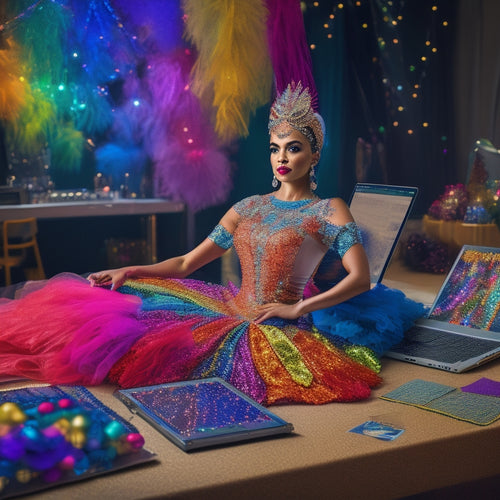
7 Best Online Dance Makeup Courses for Pros
Share
As a pro makeup artist, you're likely enthusiastic to refine your skills in stage makeup, character design, and special effects to take your dance performances to the next level. Online courses can provide the perfect solution. Look for courses that cover essentials like skin tone, facial structure, and sweat-resistant products, as well as character design, prosthetics, and airbrush techniques. With a focus on ballet, contemporary, jazz, and commercial dance styles, these courses can help you master realistic wounds, natural aesthetics, and bold designs. To elevate your skills, explore online courses that cater to pros like you - explore further to discover the best ones.
Key Takeaways
• Look for courses taught by industry experts with experience in dance makeup to ensure high-quality instruction.
• Consider courses that cover a range of topics, including stage makeup essentials, character design, and special effects.
• Online courses should offer flexible learning options, such as video lessons, downloadable resources, and online communities for support.
• Check for courses with a focus on advanced airbrush techniques, as this is a crucial skill for dance makeup artists.
• Read reviews and testimonials from previous students to get an idea of the course's effectiveness in improving skills and knowledge.
Mastering Stage Makeup Essentials
By the time you step onto the stage, you should have already mastered the fundamentals of stage makeup, including selecting the right products, understanding skin tones, and creating a flawless base.
As a professional, you know that Makeup Fundamentals are important for achieving a polished look that's Performance Ready. To guarantee a seamless application, it's vital to understand your dancer's skin tone, facial structure, and personal preferences.
When it comes to products, invest in high-quality, sweat-resistant formulas that can withstand the demands of a high-energy performance. Familiarize yourself with different brush types, sponges, and applicators to achieve precise, even coverage.
Practice creating a flawless base by balancing coverage and natural-looking skin tone. A well-executed base sets the tone for the rest of the makeup design, allowing you to focus on enhancing your dancer's features rather than concealing imperfections.
Dance-Inspired Character Design
As you move beyond mastering stage makeup essentials, you're ready to bring your dancer's character to life through deliberate, dance-inspired design choices that incorporate bold colors, textures, and finishes. This is where your creativity truly shines, as you transform your dancer into a fantastical being that captivates the audience.
In dance-inspired character design, you'll explore the world of Fantasy Creatures and Mythical Beasts, where the boundaries of reality are stretched, and imagination knows no bounds. You'll learn to balance bold, vibrant colors with subtle nuances, crafting a look that's both eye-catching and believable.
By combining clever use of texture, finish, and color, you'll create a character that's both fantastical and relatable, drawing the audience into the world of the performance.
As a pro, you'll understand the importance of nuance and restraint, knowing when to hold back and when to push the boundaries of creativity. With dance-inspired character design, the possibilities are endless, and the results are truly breathtaking.
Prosthetics and Special Effects
As a professional makeup artist, you'll need to master the art of prosthetic application, from choosing the right adhesives to blending edges seamlessly.
You'll explore the vast range of special effects materials, from gelatin to silicone, and learn how to select the best option for your design.
Prosthetic Application Techniques
You'll master the art of transforming performers into characters with realistic wounds, scars, and fantastical creatures by learning advanced prosthetic application techniques. This skillset is essential for prosthetic artistry, where you'll create bespoke pieces that seamlessly blend with the performer's skin.
By mastering facial reconstruction, you'll be able to create realistic wounds, scars, and facial features that tell a story.
In online dance makeup courses, you'll delve into the intricacies of prosthetic application, from selecting the right adhesives to blending edges for a seamless finish. You'll learn how to work with different materials, such as silicone, foam latex, and gelatin, to create realistic textures and colors.
With practice, you'll develop the precision and patience required to apply prosthetics that look and feel like a natural part of the performer's skin.
Special Effects Materials
Your expertise in special effects materials, including prosthetics and special effects, is crucial to creating realistic and believable transformations in dance performances.
As a professional makeup artist, you understand the importance of selecting materials that not only achieve the desired visual effect but also prioritize Material Safety.
You'll learn to navigate the vast range of special effects materials, from silicone to foam latex, and understand their unique properties and applications.
Additionally, you'll discover how to innovate and push the boundaries of FX Innovation, creating truly show-stopping effects that elevate the dance performance to new heights.
By mastering the art of special effects materials, you'll be able to craft bespoke looks that transport audiences to new worlds and leave a lasting impression.
With the right knowledge and skills, you'll be empowered to unleash your creativity and bring even the most ambitious visions to life.
Creating Realistic Wounds
By mastering the art of creating realistic wounds using prosthetics and special effects, you can elevate your makeup skills to a new level, crafting visually stunning and believable injuries that captivate audiences. This skill is particularly valuable in dance performances that require trauma simulation, where realistic wounds can enhance the emotional impact of the story.
To create convincing wounds, you'll need to understand the anatomy of the skin and the effects of trauma on the human body. Here are some key considerations:
-
Color and texture: Utilize a range of colors and textures to create a realistic, three-dimensional appearance.
-
Scale and proportion: Ensure that the wound is proportional to the dancer's body and the performance context.
-
Injury storytelling: Consider the backstory of the injury and how it relates to the performance narrative.
- Durability and comfort: Guarantee that the prosthetic or special effect is comfortable for the dancer and can withstand the physical demands of the performance.
Ballet and Contemporary Looks
In ballet and contemporary dance, a natural, ethereal aesthetic is often desired, which can be achieved by emphasizing subtle, skin-like tones and soft, blended edges in your makeup design. You'll want to focus on enhancing the dancer's natural features without drawing attention away from the performance.
For a Pointe Perfection look, you'll aim to create a flawless, poreless complexion using sheer foundation and concealer. Define the brows subtly, and use a light hand when applying blush and eyeshadow.
In contemporary dance, Modern Minimalism is key. You'll want to strip the look back to basics, focusing on enhancing the dancer's natural beauty without adding unnecessary drama. Use a light touch when applying products, and opt for a 'no-makeup' makeup look. Pay attention to the skin, making sure it looks healthy and hydrated.
A soft, natural lip color and defined brows will complete the look. By mastering these subtle, understated techniques, you'll be able to create a beautiful, ethereal aesthetic that lets the dancer's talent shine.
Jazz and Commercial Dance Styles
When creating makeup looks for jazz and commercial dance styles, you'll need to amplify the dancer's features, injecting energy and personality into the design to match the high-octane performance. These dance styles are all about bold, dynamic movements, so your makeup look should reflect that.
To master jazz and commercial dance makeup, focus on the following key elements:
-
Dramatic eyes: Use bold, bright colors and dramatic liner styles to make the dancer's eyes pop.
-
Glowing skin: Achieve a radiant, sun-kissed glow to complement the dancer's energetic performance.
-
Defined brows: Shape and define the brows to frame the dancer's face and add depth to their features.
- Vibrant lips: Choose bold, bright lip colors that complement the dancer's costume and add a pop of color to the overall look.
Keep in mind the Flexibility Fundamentals of dance makeup, ensuring your design is sweat-resistant and long-lasting. Also, pay attention to Music Interpretation, as the rhythm and tempo of the music can influence your makeup choices.
Theatrical Makeup for Dance Companies
You'll need to push the boundaries of creativity and artistry with theatrical makeup for dance companies, where elaborate costumes and dramatic lighting require bold, exaggerated features that can be seen from a distance. To master this art form, you'll need to understand how to amplify the dancers' features while complementing the overall aesthetic of the performance.
| Dance Themes | Makeup Trends |
|---|---|
| Futuristic | Neon hues, metallic accents, and bold eyeliner |
| Whimsical | Pastel shades, glitter, and delicate lashes |
| Dark Fantasy | Smoky eyes, bold lips, and dramatic contours |
When working with dance companies, it's essential to consider the theme and style of the performance. By understanding the creative vision, you can tailor your makeup design to enhance the overall experience. For instance, a futuristic theme might call for neon hues and metallic accents, while a whimsical theme might require pastel shades and delicate lashes. By mastering theatrical makeup for dance companies, you'll be able to elevate the performance and bring the audience to their feet.
Advanced Airbrush Techniques
Mastering advanced airbrush techniques is essential for dance makeup artists, as it allows them to achieve intricate, high-definition designs that can withstand the intense lighting and physical demands of live performances. As a dance makeup artist, you understand the importance of precision and control when working with airbrushes. To take your skills to the next level, you'll want to focus on advanced techniques that will set you apart from the competition.
Here are some key areas to focus on:
-
Airbrush maintenance: Regularly clean and maintain your airbrushes to guarantee peak performance and prevent clogs.
-
Spray gun calibration: Learn how to adjust the spray pattern, pressure, and flow rate to achieve the desired effect.
-
Layering and blending: Master the art of building up layers of color and blending edges for smooth connections.
- Stenciling and masking: Use stencils and masking techniques to create intricate designs and patterns.
Frequently Asked Questions
Can I Take These Courses if I Have No Prior Makeup Experience?
"Don't let inexperience hold you back! You can absolutely take these courses even with no prior makeup experience. They're designed to be beginner-friendly, covering essential makeup fundamentals, so you can learn and grow with confidence."
Are the Courses Suitable for Makeup Artists of All Skill Levels?
As a makeup artist, you'll find these courses cater to all skill levels, bridging beginner barriers and skill gaps, ensuring you master dance makeup techniques, regardless of your current expertise, and confidently serve your dance clients.
Can I Access the Course Materials After Completion?
Did you know 85% of online learners prefer self-paced courses? You'll appreciate that once you've completed the course, you'll have lifetime access to the materials, enjoying course flexibility and revisiting valuable lessons whenever you need them.
Are the Courses Taught by Experienced Dance Makeup Artists?
You'll learn from industry veterans who have mastered the art of dance makeup, serving as expert mentors guiding you through the courses, sharing their wealth of knowledge and expertise to elevate your skills.
Will I Receive a Certification Upon Completing the Courses?
Upon completing the courses, you'll likely receive a certification, which is essential for establishing credibility, as accreditation importance cannot be overstated, and having a recognized credential can greatly benefit your professional reputation.
Related Posts
-

Design Stunning Dance Costumes With Online Tutorials
With online tutorials, you're just a click away from accessing stunning dance costumes that mesmerize the audience. D...
-

3 Ways to Monetize Your Dance Expertise Online
You can harness your dance expertise into a lucrative online business by leveraging your skills in three key ways. Yo...
-

Unlock Your Creativity With Dancing Sublimation File
Dancing Sublimation File is a creative catalyst that opens up a world of vibrant design possibilities, providing high...


